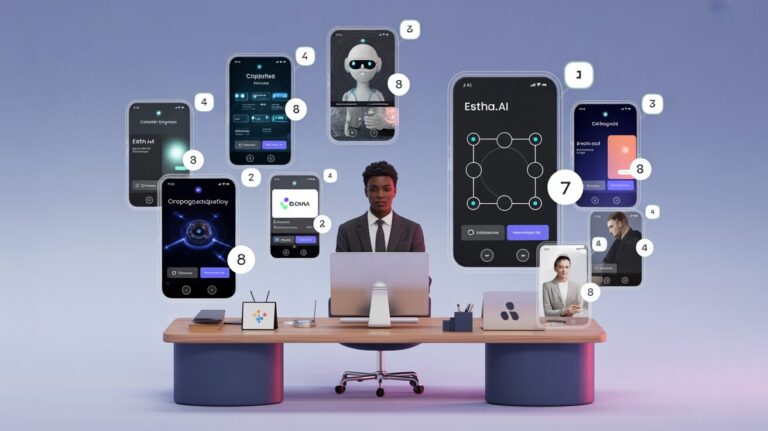Table Of Contents
- Introduction
- Understanding Low-Code and No-Code AI
- Key Differences Between Low-Code and No-Code AI
- Top Low-Code AI Platforms
- Top No-Code AI Platforms
- Choosing Between Low-Code and No-Code
- The Future of AI Development
- Conclusion
Low-Code vs No-Code AI: Comprehensive Platform Comparison Guide
The artificial intelligence revolution is no longer confined to the realm of data scientists and developers. Today, professionals across industries are leveraging AI to transform their workflows, create innovative solutions, and drive business growth—all without writing a single line of code. This democratization of AI technology has been made possible through two revolutionary approaches: low-code and no-code platforms.
While both approaches aim to make AI more accessible, they serve different audiences and offer varying levels of flexibility, customization, and technical requirements. Understanding these differences is crucial for organizations and individuals looking to embark on their AI journey without substantial technical expertise or resources.
In this comprehensive guide, we’ll explore the key distinctions between low-code and no-code AI platforms, examine the top solutions in each category, and help you determine which approach aligns best with your specific needs, technical capabilities, and business objectives.
Low-Code vs No-Code AI Platforms
A comprehensive comparison guide for choosing the right solution
Low-Code AI Platforms
Visual development environments with minimal coding requirements
- Technical Expertise: Basic programming knowledge required
- Customization: High flexibility with custom code options
- Development Time: Days to weeks
- Maintenance: May require technical expertise
- Examples: Microsoft Power Platform, Google AppSheet, Mendix
No-Code AI Platforms
Intuitive visual interfaces with zero coding requirements
- Technical Expertise: No programming knowledge needed
- Customization: Within platform boundaries
- Development Time: Minutes to hours
- Maintenance: Managed by platform provider
- Examples: Estha, Obviously AI, Levity
When to Choose Each Approach
Choose Low-Code If:
- Your team has IT professionals or citizen developers
- Project requires highly customized functionality
- You have weeks/months for development
- Technical resources available for maintenance
Choose No-Code If:
- Domain experts with limited technical skills
- Needs align with common AI use cases
- Rapid deployment is essential (days/hours)
- Business users need to maintain solutions
Spotlight: Estha No-Code AI Platform
Estha revolutionizes AI development with its intuitive drag-drop-link interface, enabling anyone to create custom AI applications without coding.
- Create AI applications in 5-10 minutes
- Zero technical expertise required
- Build chatbots, expert advisors, and virtual assistants
- Complete ecosystem with training and monetization options
Perfect for:
Understanding Low-Code and No-Code AI
Before diving into specific platforms, it’s essential to understand what low-code and no-code AI solutions actually entail and how they’re reshaping the technological landscape.
What is Low-Code AI?
Low-code AI platforms provide visual development environments that allow users to create AI applications with minimal coding requirements. These platforms typically offer a combination of drag-and-drop interfaces, pre-built templates, and visual modeling tools alongside the option to incorporate custom code when needed.
Low-code solutions strike a balance between accessibility and customization, making them suitable for users with some technical knowledge who want to accelerate development without sacrificing flexibility. They’re often targeted at citizen developers, IT professionals, and business analysts who possess basic programming concepts but may not be specialized AI experts.
What is No-Code AI?
No-code AI platforms take accessibility to the next level by completely eliminating the need for coding or programming knowledge. These platforms rely entirely on intuitive visual interfaces, pre-configured templates, and guided workflows that allow users to build functional AI applications through simple point-and-click or drag-and-drop actions.
True no-code solutions like Estha are designed for absolute beginners and domain experts who want to leverage their industry knowledge without navigating the complexities of AI development. They prioritize simplicity and rapid deployment, enabling users to create customized AI applications in minutes rather than weeks or months.
Key Differences Between Low-Code and No-Code AI
While both approaches aim to simplify AI development, several critical differences distinguish low-code from no-code platforms:
Technical Expertise Required
The most significant difference between these approaches lies in the technical knowledge barrier:
Low-Code: Requires basic understanding of programming concepts, data structures, and sometimes specific programming languages. Users need to comprehend how different components interact and may need to write custom code for complex functionalities.
No-Code: Designed for users with zero programming knowledge. Everything is abstracted behind intuitive interfaces that focus on business logic rather than technical implementation. This makes platforms like Estha accessible to professionals from any background, from educators to healthcare providers.
Customization and Flexibility
The level of customization possible varies significantly between these approaches:
Low-Code: Offers greater flexibility for customization through the ability to add custom code when needed. This makes it suitable for complex, unique use cases that may require specialized functionality beyond pre-built components.
No-Code: Provides customization within the boundaries of the platform’s capabilities and pre-built components. While this may seem limiting, advanced no-code platforms like Estha offer robust customization options through their visual interfaces, allowing users to create personalized AI applications that reflect their unique expertise without compromising on ease of use.
Development Speed
Time-to-deployment is a crucial consideration for many organizations:
Low-Code: Accelerates development compared to traditional coding but may still require days or weeks to build complex applications, especially when custom code is involved.
No-Code: Dramatically reduces development time, often allowing users to create functional AI applications in minutes or hours. For example, Estha enables users to build custom AI applications in just 5-10 minutes through its intuitive drag-drop-link interface.
Maintenance and Updates
Long-term maintenance requirements differ significantly:
Low-Code: Applications may require technical expertise for updates, especially for components involving custom code. Changes in underlying platforms or APIs might necessitate developer intervention.
No-Code: Platform providers typically handle updates and maintenance of the underlying infrastructure, allowing business users to focus on refining the application logic rather than technical maintenance.
Top Low-Code AI Platforms
Several low-code platforms have emerged as leaders in the AI development space, each with unique strengths and limitations:
Microsoft Power Platform
Microsoft’s Power Platform combines Power Apps, Power Automate, and Power BI with AI Builder to create a comprehensive low-code ecosystem. It excels in enterprise environments already invested in Microsoft products and offers strong integration with Azure Cognitive Services.
Key Features:
- AI model training with minimal coding
- Pre-built AI components for common scenarios like form processing and object detection
- Seamless integration with Microsoft 365 ecosystem
- Enterprise-grade security and compliance
Limitations: Steeper learning curve compared to pure no-code solutions; may require some technical knowledge for complex implementations.
Google AppSheet
Google’s low-code platform AppSheet incorporates AI capabilities through its Intelligent Automation features, allowing users to build apps that leverage machine learning predictions and natural language processing.
Key Features:
- Predictive modeling capabilities
- Integration with Google Cloud AI services
- Automation of repetitive tasks through AI
- Data analysis and visualization tools
Limitations: More complex AI features may require Google Cloud Platform knowledge; customization options can be limited for sophisticated AI applications.
Mendix
Mendix offers AI-powered development assistance through its Mendix Assist feature, which provides next-step suggestions and quality monitoring during application development.
Key Features:
- AI-assisted development
- Visual modeling for data integration
- Multi-channel deployment options
- Integration with external AI services
Limitations: Creating custom AI models requires technical expertise; pricing can be prohibitive for smaller organizations.
Top No-Code AI Platforms
The no-code AI landscape features several platforms designed to make artificial intelligence truly accessible to non-technical users:
Estha
As a revolutionary no-code AI platform, Estha stands out for its ability to democratize AI application development through an intuitive drag-drop-link interface that requires absolutely no coding or prompting knowledge.
Key Features:
- Create custom AI applications in just 5-10 minutes
- Intuitive visual interface requiring zero technical expertise
- Ability to build chatbots, expert advisors, interactive quizzes, and virtual assistants
- Complete ecosystem with education (EsthaLEARN), startup support (EsthaLAUNCH), and monetization options (EsthaeSHARE)
- Easy embedding into existing websites and platforms
Ideal For: Content creators, educators, small business owners, healthcare professionals, and any industry experts looking to translate their knowledge into interactive AI applications without technical barriers.
Obviously AI
Obviously AI focuses on making predictive analytics accessible through a no-code approach, allowing users to create prediction models from structured data without machine learning expertise.
Key Features:
- Automated machine learning for predictions
- Point-and-click interface for model creation
- Data preparation and cleaning tools
- Model explanation features for transparency
Limitations: Primarily focused on predictive analytics rather than comprehensive AI application development; requires structured data inputs.
Levity
Levity enables businesses to automate workflows using AI through document, image, and text classification without coding requirements.
Key Features:
- Document and image processing automation
- AI-powered workflow automation
- Integration with popular business tools
- Custom AI training for specific business needs
Limitations: More specialized in document and workflow automation rather than general-purpose AI application development.
Choosing Between Low-Code and No-Code
Selecting the right approach depends on several key factors that organizations should carefully consider:
Technical Resources Available
Assess your team’s technical capabilities honestly:
Choose Low-Code if: Your team includes IT professionals or citizen developers with basic programming knowledge who can handle some coding tasks when needed.
Choose No-Code if: You have domain experts with valuable knowledge but limited or no technical skills, or if you want to enable non-technical teams to create AI solutions independently.
Project Complexity
Consider the sophistication of your AI application:
Choose Low-Code if: Your project requires highly customized functionality, complex integrations with existing systems, or specialized algorithms that may not be available through pre-built components.
Choose No-Code if: Your needs align with common AI use cases like conversational interfaces, knowledge-based systems, or content generation where pre-built components can be configured to meet your requirements.
Timeline Constraints
Factor in your deployment timeline:
Choose Low-Code if: You have weeks or months available for development and testing, and the additional customization capabilities justify the longer timeline.
Choose No-Code if: You need rapid deployment measured in days or even hours. Platforms like Estha that enable AI application creation in minutes can be particularly valuable when time is of the essence.
Long-term Maintenance
Think about who will maintain the application:
Choose Low-Code if: You have ongoing access to technical resources who can maintain and update applications, including any custom code components.
Choose No-Code if: You need solutions that business users can maintain without developer support, or if you want the platform provider to handle most of the technical maintenance.
The Future of AI Development
As AI continues to evolve, several trends are shaping the future of low-code and no-code development:
Increasing Sophistication of No-Code Platforms
No-code platforms are rapidly advancing in their capabilities, narrowing the gap with low-code solutions. Platforms like Estha demonstrate how sophisticated AI applications can be created entirely through visual interfaces, challenging the notion that complex AI requires coding.
AI-Assisted Development
Both low-code and no-code platforms are increasingly incorporating AI to assist in the development process itself, suggesting optimal components, identifying potential issues, and even generating elements based on natural language descriptions.
Domain-Specific Solutions
The future will likely see more specialized platforms tailored to specific industries or use cases, with pre-configured components and templates designed for particular domains like healthcare, education, or retail.
Democratization of AI
The ultimate trend is the continued democratization of AI technology, making it accessible to an ever-widening audience of creators. As platforms like Estha remove technical barriers, we’ll see innovation coming from previously untapped sources—domain experts who understand real-world problems but previously lacked the technical means to address them with AI.
Conclusion
The choice between low-code and no-code AI platforms represents more than just a technical decision—it’s a strategic choice about how your organization approaches innovation and who can participate in creating AI-powered solutions.
Low-code platforms offer greater flexibility and customization for those with some technical expertise, making them suitable for complex, unique applications where specific functionality must be precisely tailored. However, they still require some programming knowledge and typically involve longer development cycles.
No-code platforms like Estha represent the next frontier in democratizing AI, removing technical barriers entirely and enabling anyone to create sophisticated AI applications regardless of their technical background. This approach dramatically accelerates development, reduces costs, and empowers domain experts to directly translate their knowledge into functional AI solutions without relying on technical intermediaries.
As AI becomes increasingly central to business operations across industries, the ability to rapidly develop and deploy AI applications without specialized technical expertise will become a significant competitive advantage. Organizations that embrace these accessible development approaches—particularly true no-code solutions—will be better positioned to innovate quickly, respond to changing market conditions, and harness the transformative potential of AI.
Whether you’re a content creator looking to build an interactive AI assistant, an educator developing personalized learning tools, or a small business owner seeking to automate customer interactions, today’s no-code AI platforms offer unprecedented opportunities to bring your ideas to life without writing a single line of code.



